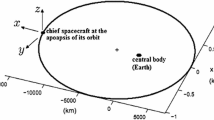Abstract
Two nonlinear feedback control laws are presented for reestablishing a desired J2 invariant relative orbit. Since it is convenient to describe the relative orbit of a deputy with respect to a chief satellite in terms of mean orbit element differences, and because the conditions for a relative orbit being J2 invariant are expressed in terms of mean orbit elements, the first control law feeds back errors in terms of mean orbit elements. Dealing with mean orbit elements has the advantage that short period oscillations are not perceived as tracking errors; rather, only the long term tracking errors are compensated for. The second control law feeds back traditional Cartesian position and velocity tracking errors. For both of the control laws, the desired orbit is computed using mean orbit elements. A numerical study compares and contrasts the two feedback laws.
Similar content being viewed by others
References
KAPILA, VIKRAM, SPARKS, ANDREW G., BUFFINGTON, JAMES M., and YAN, QIGUO “Spacecraft Formation Flying: Dynamics and Control,” Proceedings of the American Control Conference, San Diego, California, June 1999, pp. 4137–4141.
VASSAR, RICHARD H. and SHERWOOD, RICHARD B. “Formationkeeping for a Pair of Satellites in a Cicular Orbit,” Journal of Guidance, Navigation and Control, Vol. 8, No. 2, March–April 1985, pp. 235–242.
KONG, EDMUND M., MILLER, DAVID W., and SEDWICK, RAYMOND J. “Optimal Trajectories and Orbit Design for Separated Spacecraft Interferometry,” Technical Report SERC#13-98, Massachusetts Institute of Technology, November 1998.
FOLTA, DAVID C. and QUINN, DAVID A. “A Universal 3-D Method for Controlling the Relative Motion of Multiple Spacecraft in Any Orbit,” Paper No. 98-4193, AIAA/AAS Astrodynamics Specialist Conference, Boston, MA, Aug. 1998.
MIDDOUR, JAY W. “Along Track Formationkeeping for Satellites With Low Eccentricity,” Journal of the Astronautical Sciences, Vol. 41, No. 1, Jan.-March 1993, pp. 19–33.
MELTON, ROBERT G. “Time-Explicit Representation of Relative Motion Between Elliptical Orbits,” Paper AAS 97-734, AAS/AIAA Astrodynamics Specialist Conference, Sun Valley, Idaho, Aug. 1997.
CLOHESSY, W. H. and WILTSHIRE, R. S. “Terminal Guidance System for Satellite Rendezvous,” Journal of the Aerospace Sciences, Vol. 27, No. 9, Sept. 1960, pp. 653–658.
CARTER, THOMAS E. “State Transition Matrix for Terminal Rendezvous Studies: Brief Survey and New Example,” Journal of Guidance, Navigation and Control, 1998, pp. 148–155.
SCHAUB, HANSPETER and ALFRIEND, KYLE T. ‘J2 Invariant Reference Orbits for Spacecraft Formations,” Paper No. 11, Flight Mechanics Symposium, Goddard Space Flight Center, Greenbelt, Maryland, May 18–20 1999.
BROUWER, DIRK “Solution of the Problem of Artificial Satellite Theory Without Drag,” The Astronautical Journal, Vol. 64, No. 1274, 1959, pp. 378–397.
BATTIN, RICHARD H. An Introduction to the Mathematics and Methods of Astrodynamics, AIAA Education Series, New York, 1987.
TAN, ZHAOZHI, BAINUM, PETER M., and STRONG, AVAINE “The Implementation of Maintaining Constant Distance Between Satellites in Elliptic Orbits,” Paper No. 00-141, AAS Spaceflight Mechanics Meeting, Clearwater, Florida, Jan. 2000.
SLOTINE, JEAN-JACQUES E. and LI, WEIPING Applied Nonlinear Control, Prentice-Hall, Inc., Englewood Cliffs, New Jersey, 1991.
QUEIROZ, MARCIO S. De, KAPILA, VIKRAM, AND YAN, QIGUO “Nonlinear Control of Multiple Spacecraft Formation Flying,” Proceedings of AIAA Guidance, Navigation, and Control Conference, Portland, OR, Aug. 1999, Paper No. AIAA 99–4270.
MUKHERJEE, RANJAN and CHEN, DEGANG “Asymptotic Stability Theorem for Autonomous Systems,” Journal of Guidance, Control, and Dynamics, Vol. 16, Sept.–Oct. 1993, pp. 961–963.
Author information
Authors and Affiliations
Rights and permissions
About this article
Cite this article
Schaub, H., Vadali, S.R., Junkins, J.L. et al. Spacecraft Formation Flying Control Using Mean Orbit Elements. J of Astronaut Sci 48, 69–87 (2000). https://doi.org/10.1007/BF03546219
Published:
Issue Date:
DOI: https://doi.org/10.1007/BF03546219




